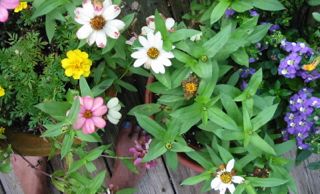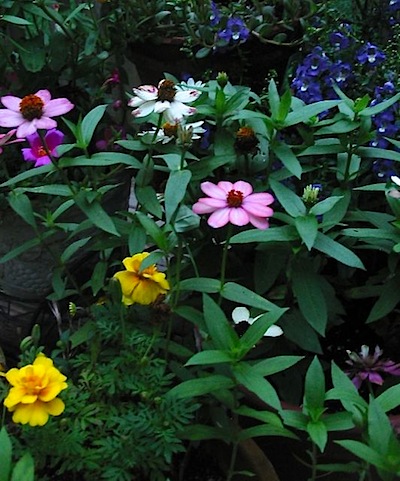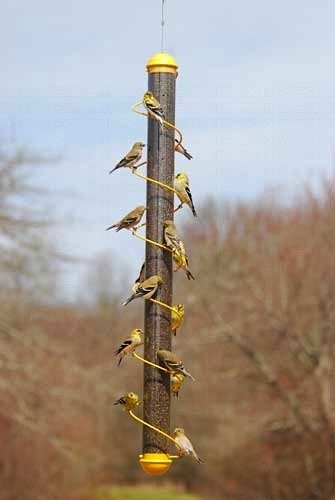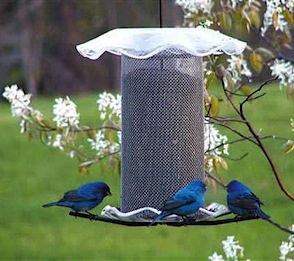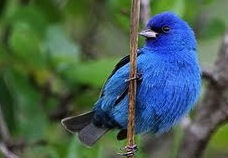-
don’t dead-head those finch feeders!
The only good thing about standing at the sink is catching the bird action on the deck! At present there’s five hummingbird feeders, two bird baths, and an open tray feeder… which squirrels usually hog. And flowers-gotta have plants and color to complete the scenery.
Hearing a rustling noise, and seeing movement in those flowers from the corner of my eye, it deserved a closer look. There were two goldfinches feeding and flitting amongst the zinnias. It was pretty cool and well worth a photo, so out on the deck I went with camera in hand. Well, the electric yellow birds didn’t make the shot… but my blue toes did 🙁
In fall, spent flowers like zinnia, coneflower, sunflower… and lots of others with seed heads provide a bounty of food for wild birds. They’re actually nature’s finch feeders. So next time you have the urge to dead-head those spent blooms… don’t! Leave them a while longer so they can do what nature intended… feed the birds.
I never did get close enough for the intended photo… but at least a better shot sans the fee
t!
-
cool spirals on these big thistle feeders
It’s a busy time for American Goldfinches as they have one of the latest breeding/nesting cycles of most backyard birds. They’re also one of very few breeds who actually molt twice a year and grow new feathers. Their electric yellow plumage is hard to miss, and most thistle feeders are seeing a good bit of traffic right now (provided the seed hasn’t gone moldy from all the rain). If yours is sitting with no takers – best to dump old seed, clean the feeder and replace with fresh thistle seed.
Innovative by design with quality construction (no cheezy plastic parts here) these 36-inch tall, large capacity thistle feeders have a cool spiral instead of perches. Featuring more feeder ports, birds really do “run the spiral” hopping from one one port to the next. This opens up space for more birds to join the party, no more waiting around for an open perch to catch some chow!
Goldfinches feed babies thistle (or nyjer) exclusively. Gross as it sounds, parents chew and prepare the tiny black seed, regurgitating it into babies’ mouths. It’s not until juveniles are out in the world that they may start to discover and eat insects. There’s a kind and quiet demeanor about this favored songbird, you’ll rarely catch them squabble at feeders. Rather than fight for a spot, most will give up and maybe try again later. Hanging a few economical thistle socks helps to alleviate this problem during peak season.
In fall when they molt again, their vibrant yellow plumage will give way to new olive drab feathers for fall and winter. It may seem like your Goldfinches have gone on their way and migrated south, but they’re still around! Keep thistle feeders out year-round to accommodate these resident birds, (and fresh water in a bath) and next summer that lemon yellow color will once again grace your yard. So popular these birds are, there’s even a birdhouse modeled after one… although typically they do nest in hedges or trees.
-
wonderfully vibrant finch feeders
Spring migrations can bring the coolest birds around. Not that we don’t enjoy our resident bluebirds, cardinals, chickadees and other usual suspects, but there’s something really exciting when one of these migratory visitors graces your yard. When one thinks “finch” it’s commonly the house, gold, or purple finch (who’s more red than purple) that come to mind.
These blue birds happen to be finches too. Indigo buntings’ vibrant plumage is just as electrifying as goldfinches’ lemony hue is during peak summer season. You’ll find buntings at finch feeders, and honestly it’s hard to miss that color. They go for tiny seeds found in finch mixes, as well as nyjer (or thistle) seed.
Their visits are always brief with us, moving further north for suitable breeding grounds. Painted buntings may also be seen at finch feeders, but we’ve spotted them only one time. So maybe it’s not the feeders themselves that are so colorful, but the spring migratory birds who frequent them… be on the look-out!

